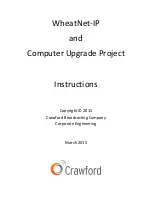
3
CTRL workstations are converted last. These are probably the simplest conversions, but typically they
are also those for which there will be the greatest time pressure (since they are located in or used by
control rooms that are on the air). With the experience gained in the first two phases of conversion, in
most cases each CTRL workstation conversion can take place in less than an hour.
Prior to beginning any part of the conversion, it is advisable to make up the cables that will connect the
blades and “PC Blades” (what WheatNet-IP calls its software drivers in Nexgen workstations) to the
WheatNet-IP network, and the cables that will connect the blades to AES and analog audio sources and
destinations.
CAT6 Ethernet cable is required for the WheatNet-IP network, and the company standard is to use
orange-jacketed cable, either riser or plenum grade as appropriate for the run.
Blades use RJ-45 connectors, and the simplest way to make connecting cables is to use riser-grade CAT5
cable, crimping an RJ-45 connector on one end and soldering XLR male or female connectors on the
other end of each short (six inches or less) “pigtail.” For AES signals, only pair 1 (white/orange) is used.
For analog, other pairs are used – consult the WheatNet-IP manual for the correct pinout for the
particular situation. Install self-laminating wire labels on both ends of each cable (including CAT6
WheatNet-IP Ethernet cables) as it is made so that there will be no mistake as to where the cable
connects.
The idea is to create a situation where the existing cables connecting to the break-out box or cable from
the old NexGen sound cards can be unplugged from those and plugged in to the new blade pigtails in a
hurry.
The following sections will take you through the various facets of the conversion process in detail.
II.
Production Room Conversion
Production room conversion entails removing the existing mixer and replacing it with the combination
of control surface/power supply, mix engine and console blade. We presume here that you already have
a Windows7 computer in place as the Nexgen production workstation. If a new computer is being
installed for this purpose, follow the instructions in Sections IV and V.
The E-6 control surface requires an external VGA monitor. Pick up a 19-inch LCD before you begin the
conversion.
In most cases, all audio cables and connections can be removed. Nexgen will need no audio connections
whatsoever. The only audio connections/cables that will be needed are:




































